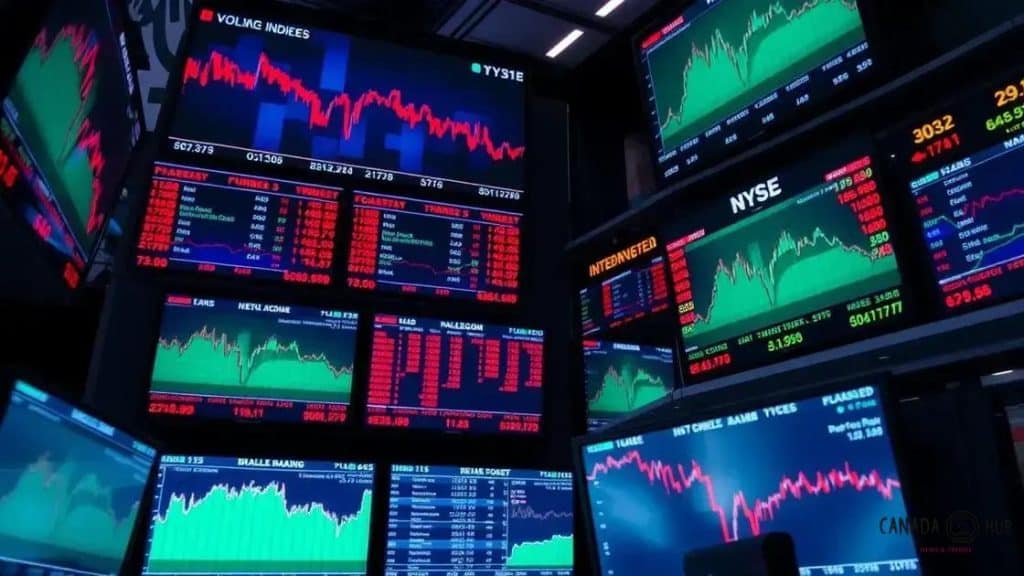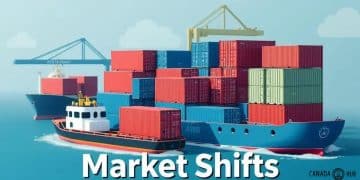Volatility in global indices after major tariff announcements

Volatility in global indices after major tariff announcements often leads to significant price fluctuations as investors react to changes in economic conditions and market sentiment.
Volatility in global indices after major tariff announcements can create ripples that affect investors and markets alike. But have you wondered how these tariffs influence trading decisions and economic stability? Let’s delve into the details.
Understanding tariff announcements and their significance
To grasp the impact of tariff announcements on the economy and markets, it’s crucial to understand their significance. Tariffs can influence prices, consumer behavior, and international connections.
What are Tariff Announcements?
Tariff announcements refer to the declarations made by governments about taxes imposed on imported goods. These tariffs can vary greatly and impact various sectors. For instance, when a government sets high tariffs on steel, it can affect industries relying on steel production.
Why Do Tariff Announcements Matter?
Understanding why these announcements are significant helps investors and consumers alike. They can shift market perception and alter stock performance instantly. Moreover, consumers may face price increases on goods as businesses attempt to compensate for higher import costs.
- Tariffs can impact overall market stability.
- They may lead to retaliatory measures from other countries.
- Changes in tariffs can affect supply chains.
As countries impose tariffs, markets react. Investors should stay aware of potential shifts that could lead to increased volatility in global indices. For example, the U.S.-China trade war saw significant market fluctuations due to ongoing tariff changes.
Keeping an eye on tariff news allows businesses to prepare for changes. In uncertain times, companies may need to adjust their pricing strategies or seek alternative suppliers. A sudden shift in tariffs can disrupt established supply chains, making it essential for companies to remain agile.
Conclusion
Analyzing tariff announcements allows us to appreciate their wide-ranging effects on the economy and market dynamics. By staying informed, individuals and businesses can navigate these changes more effectively.
Immediate effects on global stock indices

The immediate effects on global stock indices following tariff announcements can be striking. When tariffs are introduced or adjusted, investors respond quickly, reflecting their concerns or opportunities in the market.
Market Reaction Patterns
Typically, stock indices can experience sharp movements within hours of a tariff announcement. For example, an increase in tariffs often leads to a dip in stock prices. Investors may start to sell shares as uncertainty looms over potential trade wars or higher costs.
- Share prices may drop due to increased costs for businesses.
- Volatility creates opportunities for short-term traders.
- Market sentiment shifts, impacting investor confidence.
This fluctuating nature of markets reminds us how sensitive they are to global economic changes. The reactions can vary based on which countries are involved and the sectors affected by the tariff changes. For instance, industries relying heavily on exports may feel the brunt of these shifts.
Examples of Market Fluctuations
Historically, we have seen instances where announcements led to rapid changes. After the U.S. imposed tariffs on steel and aluminum, the Dow Jones Industrial Average dropped significantly in the days that followed. However, markets can also bounce back as investors reassess the long-term implications of these tariffs.
Understanding these immediate effects is essential for investors. They must stay informed and ready to adapt their strategies. While some may choose to hold on to their investments for future gains, others might look to capitalize on the volatility by trading quickly.
Ultimately, the effects on global stock indices emphasize the interconnectedness of markets, showing just how vital it is to remain informed in today’s evolving economic landscape.
Long-term market trends following tariff changes
Examining the long-term market trends following tariff changes reveals how these announcements shape economic landscapes over time. While initial reactions can be dramatic, the real impact often unfolds slowly, leading to lasting changes in market behavior.
Shifts in Consumer Behavior
One significant effect of tariff changes is how they alter consumer behavior. When tariffs are increased, prices of imported goods may rise, prompting consumers to seek alternatives. This shift can benefit domestic industries, leading to long-term growth in those sectors.
- Increased prices can lead to reduced spending on imported products.
- Local businesses may gain a competitive edge.
- Consumer loyalty can shift toward domestically produced items.
The evolution of consumer habits does not happen overnight. It often takes months or years for consumers to fully adjust to the new pricing landscape. Furthermore, as supply chains adapt to these market changes, we often see the re-emergence of industries that may have struggled before.
Investment Patterns
Investors also react to long-term trends. As certain industries thrive due to changes in tariffs, savvy investors look for opportunities in those sectors. This often leads to increased investments in domestic companies that stand to benefit. For instance, following tariff announcements on steel, construction firms may pivot to support local steel producers.
Monitoring these shifts is essential for making informed investment decisions. Long-term investors often analyze reports on industry performance post-tariff changes to identify promising sectors.
Global Trade Adjustments
Over time, nations may adjust their trade strategies based on tariff policies. This could mean forming new trade agreements or seeking out alternative markets. Countries that adapt quickly can gain a significant advantage, positioning themselves favorably in the global market.
Tariffs can lead to a reorganization of how countries interact economically. By observing these patterns, companies can strategically plan for future demand and inventory management.
Insights from recent market reactions

Analyzing insights from recent market reactions can help us understand how traders and investors respond to tariff announcements and other economic changes. Market reactions often reflect collective emotions, ranging from fear to optimism.
Understanding Market Sentiment
Market sentiment plays a crucial role in shaping how indices move. For instance, when tariffs are first announced, there can be a wave of panic selling. Investors might fear the potential of higher costs leading to lower profits. This can cause significant dips in stock prices.
- Negative sentiment can cause quick market drops.
- Positive news or adjustments can lead to rebounds.
- Traders often react to headlines rather than data.
These immediate reactions can be exaggerated. Traders often try to predict future movements based on the news cycle. As such, staying informed on the latest updates can help understand why stocks fluctuate.
Case Studies of Tariff Impacts
Recent case studies provide concrete examples of how markets responded. During the U.S.-China trade tensions, we witnessed rapid declines in tech stocks. Companies reliant on global supply chains faced uncertainties, which resulted in substantial stock sell-offs.
Conversely, sectors directly benefiting from tariffs, such as steel and manufacturing, saw increases. By examining specific instances, investors can learn which factors influenced market stability and volatility.
Long-term vs. Short-term Reactions
It’s essential to differentiate between short-term market reactions and long-term trends. Frequently, an initial dip may be followed by a recovery as companies adjust to new economic realities. For instance, after a tariff is set, businesses adapt by sourcing materials domestically or increasing efficiency.
Understanding these differences helps investors make better decisions. It encourages a strategy focused on long-term growth rather than reacting impulsively to market swings.
Strategies for investors in volatile environments
In volatile environments, having effective strategies for investors is essential. Fluctuating markets require a keen understanding of not only current trends, but also of risk management.
Diversification
One important strategy is to diversify investments. By spreading investments across different asset classes, such as stocks, bonds, and commodities, investors can reduce their exposure to risk. Diversification helps stabilize portfolios during turbulent times.
- Invest in various sectors to minimize losses.
- Include both domestic and international assets.
- Adjust the portfolio based on market conditions.
This approach ensures that if one segment of the market struggles, others may continue to perform well, protecting overall returns.
Risk Assessment
Continuously assessing risk is also crucial. Investors should understand their risk tolerance and how much volatility they can handle. This knowledge will guide their investment choices. Using tools like stop-loss orders can help lock in profits and limit losses.
Additionally, regularly reviewing the portfolio can help identify underperforming investments. Promptly addressing these can prevent significant losses during downturns.
Staying Informed
Being proactive about market news and trends allows investors to make informed decisions. Analyzing economic indicators, paying attention to global events, and understanding industry shifts can provide valuable insights. This information can help investors anticipate market changes and adjust their strategies accordingly.
Finally, remain calm and avoid making impulsive decisions based on short-term market fluctuations. Trading during moments of emotional stress can lead to mistakes. Instead, maintain a focus on long-term goals and the overall investment strategy.
In conclusion, navigating the landscape of global indices after major tariff announcements requires understanding both immediate and long-term effects. Investors benefit from strategies like diversification and consistent risk assessment to thrive in volatile environments. Staying informed about market reactions and adapting tactics accordingly can lead to better investment decisions. Ultimately, being proactive and patient is key to success in the ever-changing financial markets.
FAQ – Questions about volatility in global indices after major tariff announcements
What are the immediate effects of tariff announcements on global indices?
Tariff announcements often lead to quick reactions in global indices, with stock prices fluctuating significantly due to investor sentiment and fear of economic impact.
How can investors navigate volatility during tariff changes?
Investors can manage volatility by diversifying their portfolios, continuously assessing risk, and staying informed about market trends and economic news.
What strategies should investors use for long-term growth?
Investors should focus on diversification, regular portfolio reviews, and adapting strategies based on market conditions to ensure long-term growth.
How do tariff changes impact consumer behavior?
Tariff changes can lead to increased prices on imported goods, prompting consumers to shift their preferences toward domestically produced items, which can benefit local industries.





